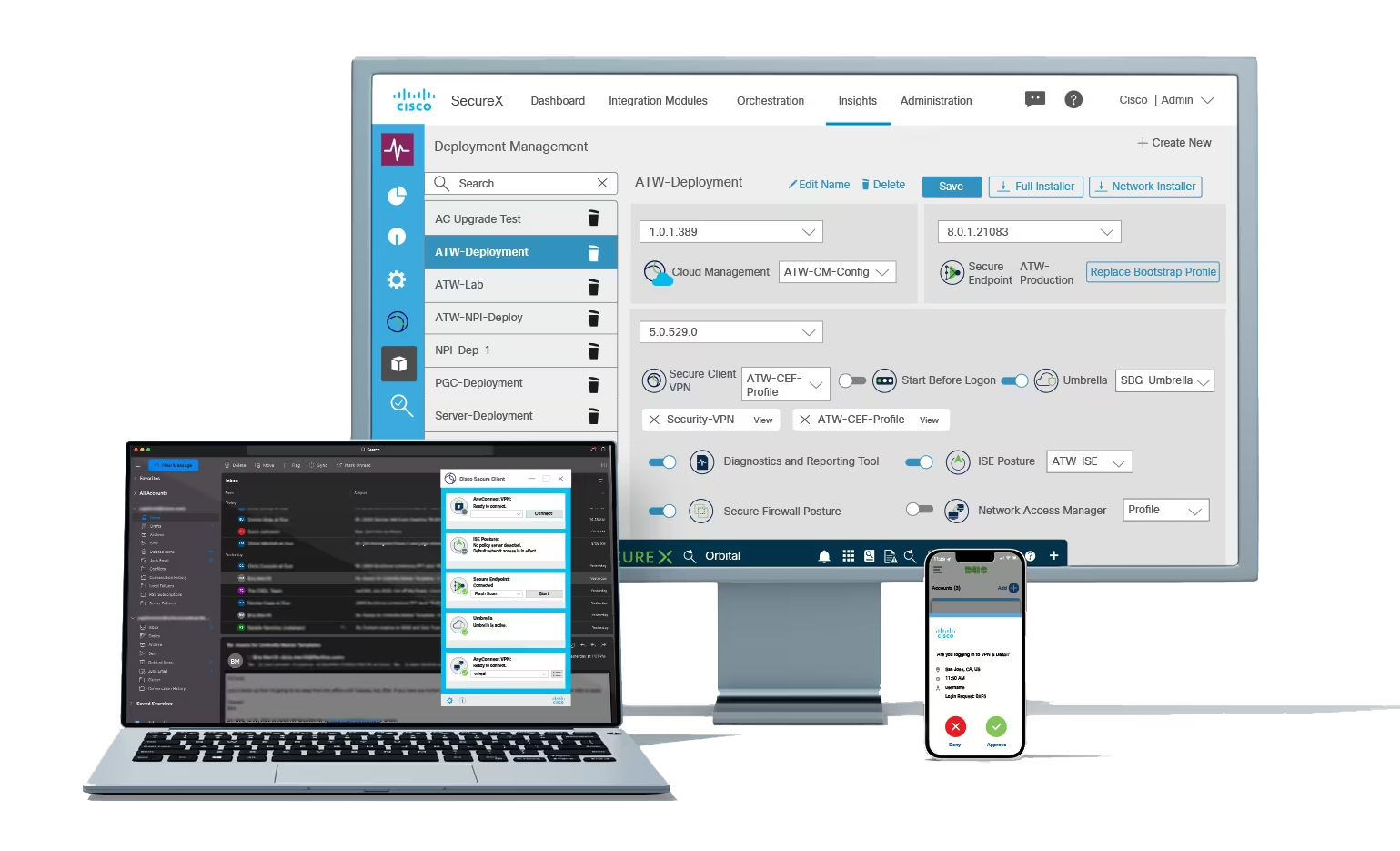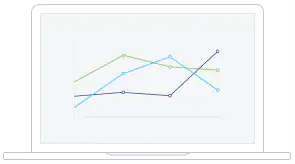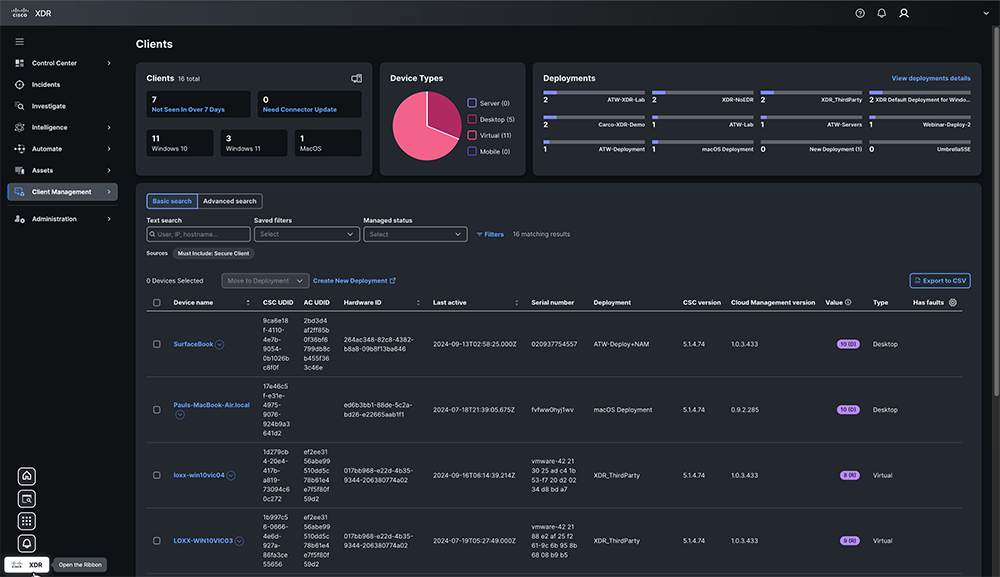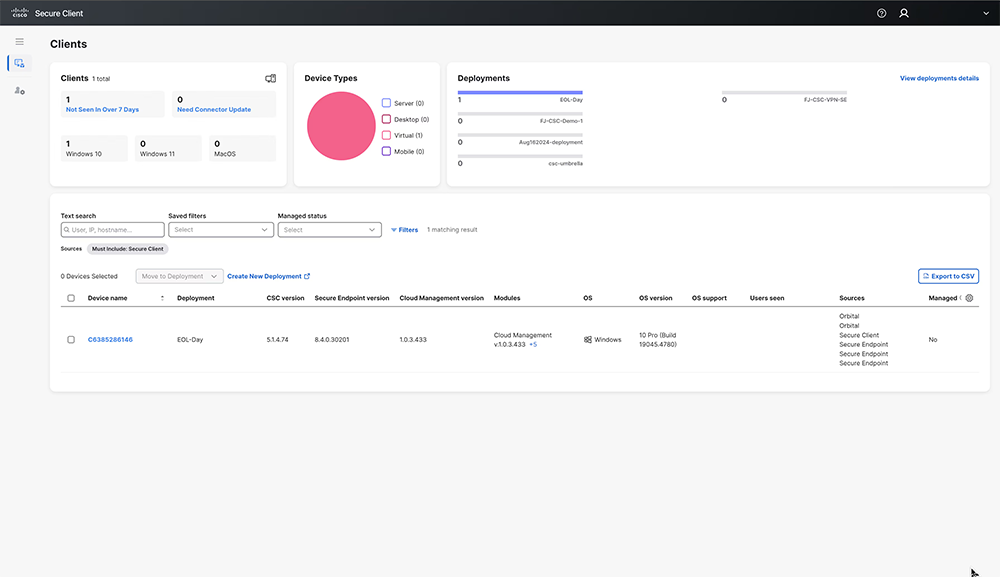Overview:
Cisco Secure Client version 5, previously known as Cisco AnyConnect Secure Mobility Client, is compatible with Windows, macOS, and Linux platforms. Users familiar with the current AnyConnect interface will find the Cisco Secure Client user interface similar, with the main differences being the new branding and updated icons.
Cisco Secure Client vs AnyConnect

Cisco Secure Client is the rebranded version of one of the most widely deployed security clients. While Cisco AnyConnect is most known as a VPN client, it has evolved significantly over the years. Today, it is more accurately described as a comprehensive security client that offers a suite of security services through its modular approach.
Important to know:
AnyConnect rebranding to Secure Client (including major version increment to 5)
- Introduction of Secure Endpoint within Cisco Secure Client as a fully functioning module
- Software maintenance for 4.x software releases ended on March 31, 2024. Maintenance releases and patches are no longer provided for AnyConnect 4.x, customers should migrate to Cisco Secure Client
- Application software support (AnyConnect 4.x) will not be available for the stated software versions beyond March 31, 2027. Software maintenance and application software support requires an active term license or active service contract for perpetual licenses. After these dates, all support services for the product are unavailable, and the product becomes obsolete. Migration path is Cisco Secure Client 5
- Cloud deployment and management of Cisco Secure Client 5 and later versions available standalone in Cisco Secure Client Cloud Management or via Cisco XDR
Note: Customers have the flexibility to continue using their existing deployment methods, including options like Cisco Secure Firewall ASA, Cisco Firepower (NGFW) , ISE, MDM/EMM, or software management tools such as SCCM. Alternatively, they can also choose to deploy using the MSI installer directly.
Screens and tools for Cloud Management including:
- Capability to customize and generate a network installer for Secure Client
- Option to create, upload, and download custom profiles for Secure Client
- Leverage the visibility provided by the Client Inventory for clients deployed via the cloud
- Available in XDR: The Client Management feature with Secure Client is the next-generation Secure Mobility Client, integrating the functionalities of both AnyConnect and Secure Endpoint with a Cloud Management solution into a single, unified end-user interface
- Available in a Stand-alone interface: Cisco Secure Client Cloud Management is the next-generation Secure Mobility Client, merging the capabilities of both AnyConnect and Secure Endpoint with a Cloud Management solution into a single, unified end-user interface
Modules and Features:
AnyConnect VPN/ZTNA User and Management Tunnels
Cisco Secure Client offers various options for automatically connecting, reconnecting, or disconnecting VPN sessions. These options make it convenient for users to connect to your VPN while supporting your network security needs. An always-on intelligent VPN allows AnyConnect client devices to automatically select the best network access point and adapt its tunneling protocol to the most efficient method. This can include the Datagram Transport Layer Security (DTLS) protocol for latency-sensitive traffic.
Tunneling support is also available for IP Security Internet Key Exchange version 2 (IPsec IKEv2). Select application VPN access can be enforced on Apple iOS, Google Android and Samsung Knox with the per-app VPN.
The management VPN tunnel ensures connectivity to the corporate network whenever the client system is powered up, not just when a VPN connection is established by the end user. This feature allows for patch management on out-of-office endpoints, especially devices infrequently connected by users via VPN to the office network. Endpoint OS login scripts requiring corporate network connectivity will also benefit from this feature.
Zero Trust Access module
The Zero Trust Access module is now available for Secure Client deployments 5.1.3.62 or later. Zero Trust Access reduces the attack surface by hiding applications, and expands your level of knowing, understanding, and controlling who and what is on your network.
Cisco Secure Endpoint
With Cisco Secure Client 5, the former AMP for Endpoints client has been unified into Cisco Secure Client, functioning as a full module and leveraging the same user interface as other modules. The Cisco Secure Endpoint Cloud, XDR Client Management, and stand-alone Cisco Secure Client Cloud Management can all deploy Cisco Secure Client with Cisco Secure Endpoint. This integration enables customers to reduce the number of clients they need to manage.
Cloud Management Module
XDR Client Management and stand-alone Cisco Secure Client Cloud Management for Cisco Secure Client 5 and greater enable administrators to create cloud managed deployments of Cisco Secure Client. This deployment configuration offers the option to download a lightweight bootstrapper, containing only the necessary information for the endpoint to connect to the cloud and receive the specified Cisco Secure Client and modules along with their associated profiles. A full installer is also available. In either case, administrators distribute the installers to the endpoints using their preferred software distribution method.
Network Visibility Module
The Network Visibility Module (NVM) provides a continuous stream of high-value endpoint telemetry, enabling organizations to monitor endpoint and user behaviors on their networks. It gathers flow data from endpoints both on- and off-premises, along with essential context such as users, applications, devices, locations, and destinations. This data is cached and sent to the Network Visibility Module Collector when the endpoint is connected to a trusted network (either the corporate network on-premises or via VPN).
The Network Visibility Module Collector is a server that receives Internet Protocol Flow Information Export (IPFIX) data, optionally filters it, and then exports it to Cisco Secure Network Analytics Endpoint License, syslog, or collectors like Splunk for on-premises collection. It processes received messages that adhere to the nvzFlow protocol specification and sends flow information only when on a trusted network. By default, no data is collected; data is collected only when configured in the profile. If collection occurs on an untrusted network, the data is cached and sent once the endpoint connects to a trusted network.
NVM is a core component of Cisco XDR. By installing the XDR Default Deployment on your endpoints, you can send telemetry directly to Cisco XDR without the need for an on-premises collector. Cisco XDR uses this data to create new detections, correlate multiple events into a single incident, and fill visibility gaps in your network.
Umbrella Roaming Security module
The Umbrella Roaming Security module requires a subscription to an Umbrella Roaming Security service, available with the Professional, Insights, Platform, or MSP package. This module provides DNS-layer security when no VPN is active, and a Cisco Umbrella subscription includes Intelligent Proxy. Additionally, Cisco Umbrella subscriptions offer content filtering, multiple policies, robust reporting, Active Directory integration, and more. The same Umbrella Roaming Security module is used regardless of the subscription level.
ISE Posture module
ISE Posture conducts a client-side evaluation. The client receives the posture requirement policy from the headend, gathers the necessary posture data, compares the results against the policy, and sends the assessment results back to the headend. Although ISE ultimately determines the endpoint’s compliance status, it depends on the endpoint’s own evaluation of the policy.
Network Access Manager
Network Access Manager is client software exclusively for Windows that ensures a secure Layer 2 network in line with its policies. It detects and selects the optimal Layer 2 access network and performs device authentication for access to both wired and wireless networks. Network Access Manager handles user and device identity as well as the network access protocols necessary for secure access. It operates intelligently to prevent end users from making connections that violate administrator-defined policies.
Secure Firewall Posture
Secure Firewall Posture, previously known as HostScan, is a package that installs on the remote device after the user connects to the Secure Firewall ASA but before the user logs in. Secure Firewall Posture can include any combination of the basic module, the endpoint assessment module, and the advanced endpoint assessment module. Note that Secure Firewall Posture is not supported on mobile devices such as Android, iOS, ChromeOS, or UWP.
ThousandEyes
The ThousandEyes Endpoint Agent is an application that gathers network and application-layer performance data when users access specific websites from within monitored networks. It enhances customers' ability to gain a comprehensive view of their application health, enabling them to make better-informed decisions and resolve issues more quickly. When ThousandEyes is installed within Secure Client, its version is displayed in the Secure Client About box upon detection. The ThousandEyes agent, as part of Cisco Secure Client, is installed using the pre-deployment method.
| Remote-Access VPN |
| Broad operating system support |
Windows 11 (64-bit), current Microsoft supported versions of Windows 10 x86(32-bit) and x64(64-bit), and Windows 8
Microsoft-supported versions of Windows 11 for ARM64-based
Microsoft-supported versions of Windows 10 for ARM64-based PCs
Note: Initial CISCO SECURE CLIENT5.0 is Windows 10/11 Only. AnyConnect supports all the above. macOS 12, 11.2, 10.15, and 10.14 (all 64-bit)
Red Hat
Ubuntu
SUSE (SLES)
See mobile data sheet for Mobile OS support
|
| Software access |
- Downloads are available in the Cisco.com Software Center
- Technical support and software entitlement for Cisco Secure Client is included Premier and Advantage licensing
- The contract number must be linked to Cisco.com ID.
|
| Optimized network access: VPN protocol choice SSL (TLS and DTLS); IPsec IKEv2 |
- Cisco Secure Client provides a choice of VPN protocols, so administrators can use whichever protocol best fits their business needs
- Tunneling support includes SSL (TLS 1.2 and DTLS 1.2) and next-generation IPsec IKEv2
- DTLS provides an optimized connection for latency-sensitive traffic, such as VoIP traffic or TCP-based application access
- TLS 1.2 (HTTP over TLS or SSL) helps ensure availability of network connectivity through locked-down environments, including those using web proxy servers
- IPsec IKEv2 provides an optimized connection for latency-sensitive traffic when security policies require use of IPsec
|
| Optimal gateway selection |
Determines and establishes connectivity to the optimal network-access point, eliminating the need for end users to determine the nearest location |
| Mobility friendly |
- Designed for mobile users
- Can be configured so that the VPN connection remains established during IP address changes, loss of connectivity, or hibernation or standby
- With Trusted Network Detection, the VPN connection can automatically disconnect when an end user is in the office and connect when a user is at a remote location
|
| Encryption |
- TLS/DTLS 1.2 strong ciphers supported
- Next-generation encryption, including NSA Suite B algorithms, ESPv3 with IKEv2, 4096-bit RSA keys, Diffie-Hellman group 24, and enhanced SHA2 (SHA-256 and SHA-384).
pplies only to IPsec IKEv2 connections. Premier (formerly AnyConnect Apex) is required
|
| Wide range of deployment options |
- Pre-deploy—New installations and upgrades are done either by the end user, or by using an enterprise Software Management System (SMS).
- Web Deploy—The Cisco Secure Client package is loaded on the headend, which is either a Secure Firewall ASA, Secure Firewall Threat Defense, or an ISE server. When the user connects to a firewall or to ISE, Cisco Secure Client is deployed to the client.
- XDR and Cisco Secure Client Cloud Management: Cisco Secure Client 5.0 can be deployed from the cloud using customizable deployment options.
|
| Wide range of authentication options |
Protocols:
- SAML 2.0 with Embedded or Native Browser (SSO)
- RADIUS
- LDAP
- Certificate
- TACACS+
- HTTP Form
Headend Methods
- AAA
- AAA and Certificate
- Certificate Only
- SAML
- Multiple Certificates and AAA
- Multiple Certificates
|
| Consistent user experience |
- Full-tunnel client mode supports remote-access users requiring a consistent LAN-like user experience
- Multiple delivery methods help ensure broad compatibility of AnyConnect
- User may defer client software updates if configured by the Administrator
|
| Centralized policy control and management |
- Policies can be preconfigured or configured locally and can be automatically updated from the VPN security gateway
- API for AnyConnect eases deployments through webpages or applications
- Checking and user warnings are issued for untrusted certificates
|
| Advanced IP network connectivity |
- Public connectivity to and from IPv4 and IPv6 networks
- Access to internal IPv4 and IPv6 network resources
- Administrator-controlled split-tunneling (Network and Dynamic (domain) and full tunnel network access policy
- Access control policy using Dynamic Access Polices or the identity Services Engine
- Per-app VPN policy for Apple iOS, Google Android, and Samsung Knox
IP address assignment mechanisms:
- Static
- Internal pool
- Dynamic Host Configuration Protocol (DHCP)
- RADIUS/Lightweight Directory Access Protocol (LDAP)
|
| Robust unified endpoint compliance |
- Endpoint posture assessment and remediation is supported for wired and wireless environments (replacing the Cisco Identity Services Engine NAC Agent). Requires Identity Services Engine (ISE) with Identity Services Engine Premier license
- ISE Posture (working in conjunction with ISE) and Host Scan (VPN only) seeks to detect the presence of anti-malware software, Windows service packs/ patching state, and range of other software services on the endpoint system prior to granting network access
- Administrators also have the option of defining custom posture checks based on the presence of running processes
- ISE Posture and Host Scan can detect the presence of a watermark on a remote system. The watermark can be used to identify assets that are corporate owned and provide differentiated access as a result. The watermark-checking capability includes system registry values, file existence matching a required CRC32 checksum, and a range of other capabilities. Additional capabilities are supported for out-of-compliance applications
|
| Client firewall policy |
- Provides added protection for split-tunneling configurations
- Used in conjunction with the AnyConnect module and Cisco Secure Client to allow for local-access exceptions (for example, printing, tethered device support, and so on)
- Supports port-based rules for IPv4 and network and IP Access Control Lists (ACLs) for IPv6
- Available for Windows and macOS platforms
|
| Localization |
In addition to English, the following language translations are included:
- cs-CZ Czech (Czech Republic)
- de-DE German (Germany)
- es-ES Spanish (Spain)
- fr-CA French (canada)
- fr-FR French (france)
- hu-HU Hungarian (Hungary)
- it-IT Italian (Italy)
- ja-JP Japanese (Japan)
- ko-KR Korean (Korea)
- nl-NL Dutch (Netherlands)
- pl-PL Polish (Poland)
- pt-BR Portuguese (Brazil)
- ru-RU Russian (Russia)
- zh-CN Chinese (China)
- zh-HANS Chinese (Simplified)
- zh-HANT Chinese (Traditional)
- zh-TW Chinese (Taiwan)
|
| Ease of client administration |
- Administrators can automatically distribute software and policy updates from the headend security appliance thereby eliminating administration associated with client software updates. Cisco Secure Client 5 also offers Administrators the ability to deploy and manage via Client Management (available via Cisco XDR or standalone)
- Administrators can determine which capabilities to make available for end-user configuration
- Administrators can trigger an endpoint script at connect and disconnect times when domain login scripts cannot be utilized
- Administrators can fully customize and localize end-user visible messages
|
| Profile editor |
- AnyConnect policies may be customized directly from Cisco Adaptive Security Device Manager (ASDM)
- Stand-alone Profile Editor
- XDR Client Management or Cisco Secure Client Cloud Management: The profile configuration page includes settings for Cloud Management functionality and various client modules, such as ISE Posture, Network Visibility Module, Cisco Secure Endpoint, Customer Experience Feedback, and VPN
|
| Diagnostics |
- On-device statistics and logging information are available
- Logs can be viewed on device
- Logs can be easily emailed to Cisco or an administrator for analysis
|
| Federal Information Processing Standard (FIPS) |
FIPS 140-2 level 2 compliant (platform, feature, and version restrictions apply) |
|
Secure Mobility and Network Visibility
|
| Cisco Umbrella Roaming (Cisco Umbrella Roaming license required) |
- The Umbrella Roaming Security module requires a subscription to the Umbrella Roaming Security service, which can be obtained through DNS Security Essentials, DNS Security Advantage, SIG Essentials, or SIG Advantage plans. This module offers DNS-layer security when no VPN is active. A Cisco Umbrella subscription enhances this with Intelligent Proxy capabilities. Additionally, Cisco Umbrella subscriptions offer features such as content filtering, multiple policy management, comprehensive reporting, Active Directory integration, and more. The same Umbrella Roaming Security module is utilized across all subscription plans
- Enforce security for roaming devices when the VPN is off
- Automatically block malware, phishing, and C2 callbacks on roaming devices
- Simplest way to protect devices anywhere they go
- Utilize endpoint redirection to enforce DNS-based security when the VPN is off or with split tunnels (applies to communication outside tunnel)
|
| Network Visibility Module |
- Capture endpoint flows with detailed information about users, endpoints, applications, locations, and destinations
- Enable flexible collection settings for both on-premises and off-premise environments
- Monitor application usage to uncover potential behavioral anomalies
- Facilitate more informed network design decisions
- Share usage data with NetFlow analysis tools, such as Cisco Network Analytics
|
| Cisco Secure Endpoint (Cisco Secure Endpoints licensed separately) |
- Cisco Secure Client 5 is a unified agent that integrates the functionalities of the former AnyConnect and AMP for Endpoints, now known as Cisco Secure Endpoint. In its initial release, available exclusively for Windows, administrators can leverage a single agent to deliver both Cisco Secure Client and Cisco Secure Endpoint functionalities through a unified client and user interface
- Extends endpoint threat services to remote endpoints, increasing endpoint threat coverage
- Provides more proactive protection to further assure an attack is mitigated at the remote endpoint quickly
|
| ThousandEyes |
- Licensed separately the Endpoint Agent is an application designed to collect performance data at both the network and application layers when users access specific websites within monitored networks
- This tool enhances customers’ ability to gain a comprehensive view of their application health, enabling them to make more informed decisions and resolve issues more swiftly
- When ThousandEyes is installed within the Secure Client, its version is displayed in the Secure Client About box upon detection
|
|
Network Access Manager and 802.1X
|
| Media support |
- Ethernet (IEEE 802.3)
- WI-FI (IEEE 802.11
|
| Network authentication |
- IEEE 802.1X-2001, 802.1X-2004, and 802.1X-2010
- Enables businesses to deploy a single 802.1X authentication framework to access both wired and wireless networks
- Manages the user and device identity and the network access protocols required for highly secure access
- Optimizes the user experience when connecting to a Cisco unified wired and wireless network
|
| Wireless encryption protocols |
- WEP: (Wired Equivalent Privacy
- WPA: (Wi-Fi Protected Access)
- WPA2: Advanced Encryption Standard (AES) for encryption support
- WPA3: CCMP-128 and GCMP-256 support
- Enhanced Open: Provides unauthenticated data encryption to users, an improvement over traditional open networks with no protection at all. It is based on Opportunistic Wireless Encryption (OWE)
|
| Session resumption |
- RFC2716 (EAP-TLS) session resumption using EAP-TLS, EAP-FAST, EAPPEAP, and EAP-TTLS
- EAP-FAST stateless session resumption
|
| Ethernet encryption |
- Media Access Control: IEEE 802.1AE (MACsec)
- Key management: MACsec Key Agreement (MKA)
- Defines a security infrastructure on a wired Ethernet network to provide data confidentiality, data integrity, and authentication of data origin. Safeguards communication between trusted components of the network
|
| One connection at a time |
- Allows only a single connection to the network disconnecting all others
- No bridging between adapters
- Ethernet connections automatically take priority
|
| Complex server validation |
- Supports “ends with” and “exact match” rules
- Support for more than 30 rules for servers with no name commonality
|
| EAP-Chaining (EAP-FASTv2) |
- Differentiates access based on enterprise and non-enterprise assets
- Validates users and devices in a single EAP transaction
|
| Enterprise Connection Enforcement (ECE) |
- Helps ensure that users connect only to the correct corporate network
- Prevents users from connecting to a third-party access point to surf the Internet while in the office
- Prevents users from establishing access to the guest network
- Eliminates cumbersome blocked listing
|
| Next-generation encryption (Suite B) |
- Supports the latest cryptographic standards
- Elliptic Curve Diffie-Hellman key exchange
- Elliptic Curve Digital Signature Algorithm (ECDSA) certificates
|
| Credential types |
- Interactive user passwords or Windows passwords
- RSA SecurID tokens
- One-Time Password (OTP) tokens
- Smartcards (Axalto, Gemplus, SafeNet iKey, Alladin)
- X.509 certificates
- Elliptic Curve Digital Signature Algorithm (ECDSA) certificates
|
|
Zero Trust Access (ZTA Module)
|
| Zero Trust Access Module |
- When you see “Enrolled in Zero Trust Access” in the Cisco Secure Client Tile, it indicates that Zero Trust Access is enabled and running
- This access model focuses on knowing, understanding, and controlling who and what is on your network. By definitively identifying users, the appropriate level of access is granted based on their role or function, and the network rights associated with those roles
- Beyond the traditional AnyConnect VPN, Zero Trust Access offers more granular control and a secure user experience for a comprehensive network solution. Unlike VPNs, which may trust any entity that passes network control, the Zero Trust Access approach does not trust any user or device until it is verified. No one is automatically trusted; once verified, users are granted limited access and are subject to continuous re-verification
- This model extends the zero-trust principle beyond the network, reducing the attack surface by concealing applications from the internet and ensuring that only authenticated and authorized users can access network resources
|
| ZTNA Support |
Currently supported by the Cisco Secure Access solution |
| System Requirements |
- Supported on Windows 10 and 11 (TPM-enabled devices) and macOS 11, 12, 13, and 14
(TPM-enabled devices)
- Windows devices must be running on systems that include Trusted Platform Module version 2.0
- macOS devices must be running on systems that include a Secure Enclave such as MacBook Pro computers with Touch Bar (2016 and 2017) that contain the Apple T1 chip
- Intel-based Mac computers that contain the Apple T2 Security chip, or Mac computers with Apple silicon
- You must have Windows WebView2 installed if you are going to use the Zero Trust Access Module, and you must deploy it out of band
- If you are pre-deploying Zero Trust Access on macOS 11 or greater, refer to Additional Duo Desktop Requirements on macOS 11 (and later) for additional requirements iOS/iPadOS 17.2 (or later)
- Samsung device running Android version 14+ and Samsung Knox 3.10 or higher
|
| Cisco Secure Client |
Please refer to the Cisco Secure Client Release Notes for the latest support information |
At-a-Glance:
Investigation and response to cybersecurity incidents should not require more than 20 endpoint tools. Consolidating and simplifying security at the Endpoint is vital, but it becomes increasingly complex with every deployed security tool in your environment. Using multiple solutions can increase the time it takes for incident analysis and security system maintenance, not to mention that the learning curve is tremendous. It would help if you had a solution that takes the burden of managing and monitoring multiple endpoint applications. That’s where Cisco Secure Client steps in.
Features and Benefits
Cisco Secure client is the next generation of AnyConnect. It enhances the modular approach of AnyConnect and introduces Cisco Secure Endpoint as a fully integrated module into the new Cisco Secure Client.
Existing customers will still enjoy a familiar and user-friendly experience. Existing Secure Endpoint (AMP for Endpoints) users will find the end user interface easy to navigate.
We are introducing the ability to deploy, update and manage Cisco Secure Client from the Cloud. This provides customers another deployment option to our long-existing deployment options; Pre-deploy (SCCM, MSI), Web Deploy with VPN Headends, Secure Firewall, and the Identity Services Engine. Cloud Management is an optional feature.
Cloud Management allows for different deployment installers that contain the modules and associated profiles that best fit the groups of users. The software will access the cloud transparently based on an administrative configuration in the CM profile. The user is no longer required to be on-premise either physically or via VPN to be updated.
Benefits For Security Administrators
- Low total cost of ownership from a single client providing multiple services
- Context-aware, comprehensive, and continuous endpoint security
- Extending flexible, policy-driven access to corporate resources across wired, wireless, and VPN.
Benefits For End Users
- Highly secure access across popular PC and mobile devices
- Consistent user experience
- Intelligent, dependable, and always-on connectivity
- Rebranded AnyConnect UI
- Unified Agent
- Cisco Secure Endpoint Module
- Cloud Managed option
- Pathway to Zero Trust Network Access
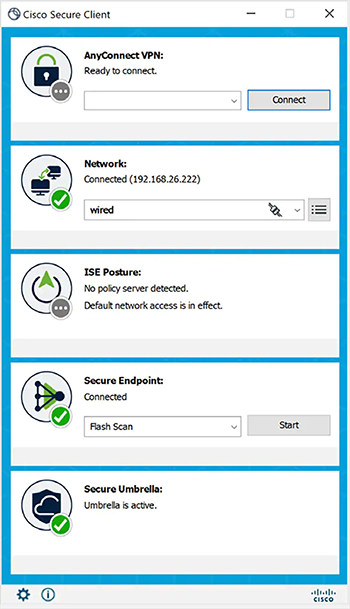
| Features |
Description |
| AnyConnect VPN/ ZTNA User |
Cisco Secure Client provides many options for automatically connecting, reconnecting, or disconnecting VPN sessions. These options offer a convenient way for your users to connect to your VPN and support your network security requirements. |
| AnyConnect VPN Management Tunnels |
Management VPN tunnel provides connectivity to the corporate network whenever the client system is powered up, not just when the end-user establishes a VPN connection. As a result, you can perform patch management on out-of-the-office endpoints, especially devices that are infrequently connected by the user, via VPN, to the office network. |
| Cisco Secure Endpoint Module |
Available with Cisco Secure Client for Windows, Secure Endpoint functions as a module within Cisco Secure Client and is accessible via the Cisco Secure Client user interfaces. The Cisco Secure Endpoint Cloud can also deploy Cisco Secure Client with Cisco Secure Endpoint, as can the SecureX Cloud Management. |
| Cloud Management Module |
SecureX Cloud Management Deployment for Cisco Secure Client enables Administrators to create cloud-managed deployments of Cisco Secure Client. The deployment configuration generates the option to download a lightweight bootstrapper that contains the information needed by the endpoint to contact the cloud for the specified Cisco Secure Client modules by the deployment with their associated profiles. |
| Network Visibility Module |
The Network Visibility Module delivers a continuous feed of high-value endpoint telemetry, which allows organizations to see endpoint and user behaviors on their networks. It collects flow from endpoints on and off-premises and valuable contexts like users, applications, devices, locations, and destinations. It caches this data and sends it to the Network Visibility Module Collector when it is on a trusted network (the corporate network on-prem or through VPN). |
| Umbrella Roaming Security module |
To take advantage of Umbrella Roaming Security service, you need the Professional, Insights, Platform, or MSP package subscriptions. Umbrella Roaming Security provides DNS-layer security when no VPN is active and adds an Intelligent Proxy. |
| ISE Posture module |
ISE Posture is a module you can choose to install as an additional security component of the Cisco Secure Client product. Perform endpoint posture assessment on any endpoint that fails to satisfy all mandatory requirements and is deemed non-compliant. |
| Network Access Manager |
Network Access Manager manages user and device identity and the network access protocols required for secure access. It works intelligently to prevent end-users from making connections that violate administrator-defined policies. |
| Posture (for Secure Firewall) |
Secure Firewall Posture performs server-side evaluation where the Secure Firewall asks only for a list of endpoint attributes such as operating system, IP address, registry entries, local certificates, and filenames, and they are returned by Secure Firewall Posture. |
Cisco Secure Client — Way more than VPN:
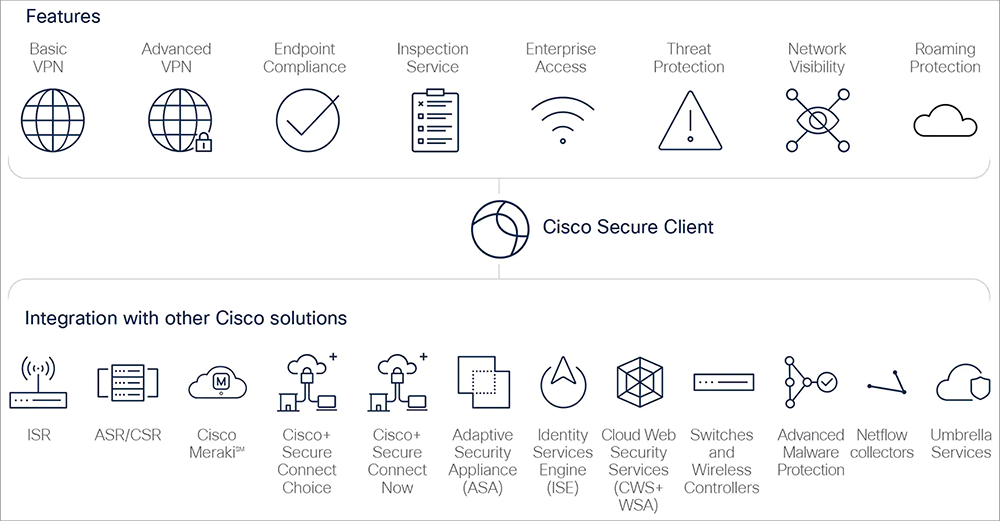
Licensing Options
Cisco offers the following licensing models for Secure Client:
- Secure Client Advantage License
- Formerly known as AnyConnect Plus.
- Available as a subscription license.
- Provides essential VPN and security features suitable for most business needs.
- Secure Client Premier License
- Formerly known as AnyConnect Apex.
- Available as a subscription license.
- Includes all features of the Advantage License plus additional capabilities such as network visibility, unified endpoint compliance, and advanced encryption standards for organizations with more complex security requirements.
- Secure Client VPN Only – Perpetual License
- Designed for VPN-only environments.
- Licensed based on a single headend device and simultaneous connections, not authorized users.
- Does not support other Secure Client functions or services.
- Secure Client Advantage – Perpetual License
- Provides the same features as the Advantage subscription license but with perpetual usage rights.
User Tier Licensing
Licenses are structured based on the number of unique or authorized users. The available user tiers are:
- 25–99 Users
- 100–249 Users
- 250–499 Users
- 500–999 Users
- 1,000–2,499 Users
- 2,500–4,999 Users
- 5,000–9,999 Users
- 10,000–24,999 Users
- 25,000–49,999 Users
- 50,000–99,999 Users
- 100,000 or more Users
The minimum user license size is 25.
Key Considerations
- Subscription Terms: Subscription licenses are typically offered in 1, 3, or 5-year terms.
- License Stacking: Secure Client Advantage and Premier licenses can be stacked, allowing for flexibility in deployments.
- User Count Determination: Licenses are based on the total number of unique or authorized users, not simultaneous connections.
- VPN Only License Limitations: VPN Only licenses are concurrent endpoint-based and applied per individual ASA. They are not portable and cannot be combined with Plus or Apex licenses.

